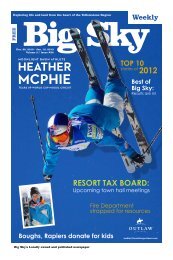HEALTH Strings Under the Big Sky - Explore Big Sky
HEALTH Strings Under the Big Sky - Explore Big Sky
HEALTH Strings Under the Big Sky - Explore Big Sky
Create successful ePaper yourself
Turn your PDF publications into a flip-book with our unique Google optimized e-Paper software.
Electrolyte (salt), carbohydrate (sugar) and water<br />
replacement during aerobic exercise lasting greater<br />
than one hour can improve athletic performance and<br />
decrease <strong>the</strong> risk of dehydration or hyponatremia<br />
(low sodium concentration).<br />
The American College of Sports Medicine recommends<br />
that in general, athletes should consume<br />
about 500 – 700mg of sodium for every liter of<br />
fluid and 30 – 60mg of carbohydrates per hour during<br />
sustained aerobic activity. Water replacement<br />
during exercise depends on a variety of factors but<br />
most athletes should consume about .4 – .8 liters per<br />
hour during sustained exercise, with higher rates<br />
for warmer environments and lower rates for cooler<br />
environments. A variety of products are available to<br />
help an athlete obtain <strong>the</strong> recommended balance of<br />
salt, sugar and water during exercise.<br />
Here, I’ve reviewed one type of carbohydrate and<br />
electrolyte replacement product that’s popular<br />
among triathletes, cyclists and runners: <strong>the</strong> carbohydrate<br />
gel.<br />
58 June 29, 2012<br />
noun: wild or rough terrain<br />
adjacent to a developed area<br />
origin: shortened form of<br />
“back 40 acres”<br />
explorebigsky.com<br />
Carbohydrate gels are an excellent way to fuel your<br />
body and replace lost electrolytes during aerobic<br />
exercise. Most come in single serving packages<br />
and contain a carbohydrate source and electrolytes<br />
(mainly sodium and potassium). These gels are also<br />
available with varying levels of caffeine. In addition,<br />
some brands also contain a protein source, calcium<br />
or antioxidants. The data is not as convincing<br />
for o<strong>the</strong>r products often included in carbohydrate<br />
gels, with <strong>the</strong> exception of caffeine.<br />
Caffeine is known as <strong>the</strong> most commonly used<br />
drug in <strong>the</strong> world and has been used by athletes to<br />
improve athletic performance for many years. Specifically,<br />
caffeine improves performance during prolonged<br />
moderate-to-high intensity exercise lasting<br />
greater than 30 minutes. Most studies have shown<br />
that <strong>the</strong> optimal dose of caffeine for improving performance<br />
during exercise is 3 – 6mg per kilogram of<br />
body weight. However, more recent data has shown<br />
a performance benefit with caffeine doses as low as<br />
1mg per kilogram of body weight. So, a 175-pound<br />
individual (about 80 kgs) would have to consume<br />
about 80 – 480mg of caffeine during exercise to<br />
obtain a performance-enhancing effect.<br />
explorebigsky.com<br />
For <strong>the</strong> big sky weekly, <strong>the</strong> back 40 is a resource: a<br />
place where we can delve into subjects and ask experts<br />
to share <strong>the</strong>ir knowledge. topics include regional<br />
history, profiles of local artists and musicians, snow and<br />
avalanche education, how-to pieces for traditional or<br />
outdoor skills, and science.<br />
big sky weekly<br />
a review of <strong>the</strong> most popular carbohydrate and caffeine gels for endurance athletes<br />
by eriC anderson, m.d.<br />
big <strong>Sky</strong> weekly contributor<br />
"Carbohydrate gels are an<br />
excellent way to fuel your body<br />
and replace lost electrolytes<br />
during aerobic exercise."<br />
If you choose to use caffeine during exercise,<br />
begin with <strong>the</strong> lowest dose for your weight to<br />
minimize <strong>the</strong> chance of side effects. Levels of<br />
caffeine in <strong>the</strong> blood usually stay high for about<br />
three to four hours after ingestion and are mostly<br />
gone within six to seven hours. Intake should<br />
be about 30 – 60 minutes prior to exercise to<br />
ensure levels are high when <strong>the</strong> exercise begins.<br />
During longer events, consumption of caffeine<br />
during regular intervals has a similar performance<br />
enhancing effect to taking <strong>the</strong> entire dose prior<br />
to exercise. Contrary to popular belief, caffeine<br />
consumption during exercise has not been shown<br />
to have a negative effect on hydration status or<br />
heat tolerance.<br />
All gels are not <strong>the</strong> same, so read nutrition labels<br />
to make sure <strong>the</strong> product is in line with your<br />
nutrition and electrolyte replacement plan.<br />
Eric Anderson is a sports medicine physician with<br />
Rockwood Clinic in Spokane, Wash. A competitive<br />
Category 1 cyclist and avid alpine and nordic<br />
skier, he lives in Spokane with his wife and two<br />
daughters.
















